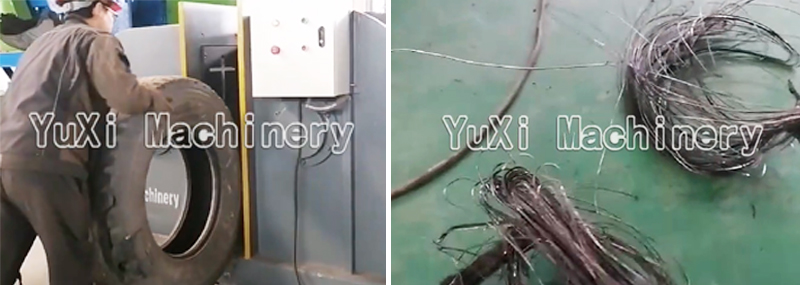In the scrap tire recycling industry chain, the separation of steel wire and rubber is the core link that determines the purity and value of finished products—and the tire wire drawing machine (double-hook wire drawing machine) is the key equipment to achieve efficient and precise separation in this link. Today, we’ll break down this equipment’s functions, applicable scenarios, operating logic, and core advantages in depth, and see how it lays a solid foundation for the production of high-purity rubber powder.

A tire wire drawing machine, also known as a tire steel wire pulling machine, is specialized equipment designed to process “crushed radial tire beads.”
Its core principle is: Using two high-strength alloy hooks, it precisely catches and pulls out the steel wire embedded in the tire bead, achieving complete physical separation of steel wire and rubber—it neither damages the integrity of the steel wire nor leaves excessive steel wire residues in the rubber, providing clean rubber raw materials for the subsequent production of high-purity rubber powder.
This equipment is not “all-purpose” but designed for specific forms of tire materials, mainly suitable for:
In short, it is a specialized separation device in the tire recycling process (after rough shredding and before fine processing), focusing on the细分 link of “separating steel wire and rubber in tire beads.”
The operation process of a tire wire drawing machine is highly automated; only simple loading is required to complete the full-process separation. The specific steps are as follows:
In the tire recycling process, the efficiency and purity of steel wire separation directly affect the quality of subsequent rubber powder. The 4 key features of tire wire drawing machines make them the optimal solution for this link:
1.High Efficiency and Strong Power, Stable Output
The unique double-hook design applies both internal and external forces to the bead simultaneously, with a pulling speed of 10 cycles per minute. A single unit processes approximately 550 lbs per hour, ensuring stable throughput for mass production;
2.Thorough Separation, Enhancing Raw Material Value
The integrity rate of pulled steel wire exceeds 99.8%, and steel wire residue in rubber is ≤0.2%, which greatly improves the purity of subsequent rubber powder (reducing impurities) and thus enhances the downstream application value of the rubber powder;
3.Durable, Low Operation and Maintenance Costs
Core components (such as hooks and clamping devices) are made of AISI 4140 alloy steel and undergo carburizing and quenching treatment (surface hardness: HRC 58-62), featuring strong wear resistance and a trouble-free operation time of over 8,000 hours, reducing equipment maintenance and replacement costs;
4.Automated Operation, Reducing Labor and Costs
Except for the loading link (which requires manual assistance), the rest of the process is fully automated. A single unit only needs 1 operator, reducing labor intensity and labor costs.

For scrap tire recycling enterprises, the value of tire wire drawing machines goes beyond “separating steel wire”—its existence is the core support for realizing “high-value recycling of full tire resources”:

From “piled-up scrap tire beads” to “clean rubber raw materials + intact recycled steel wire,” the tire wire drawing machine may seem like a “niche link device,” but it is actually a key node for “improving quality and efficiency” in the scrap tire recycling industry chain—it makes the process of “turning waste into treasure” more precise and efficient, and maximizes the value of recycled resources.